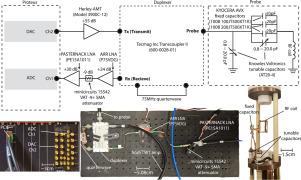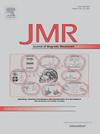High-speed, high-memory NMR spectrometer and hyperpolarizer
IF 1.9
3区 化学
Q3 BIOCHEMICAL RESEARCH METHODS
引用次数: 0
Abstract
We report on the development of a novel nuclear magnetic resonance (NMR) spectrometer, incorporating a high-speed, commercially available arbitrary waveform transceiver (AWT) – Tabor Proteus P9484M. The spectrometer is optimized for integrated electron-nuclear spin control and dynamic nuclear polarization (DNP) and leverages the AWT’s rapid sampling rate (9 Gs/s), significant memory capacity (16 GB), and efficient data transfer capabilities (6 Gs/s). These features enable effective NMR transmit–receive operations and electron control for DNP. In particular, the high sampling rates permit NMR pulse synthesis and signal reception directly at the Larmor frequency up to 2.7 GHz. This can yield NMR signal-to-noise ratio (SNR) improvements by obviating the need for signal heterodyning. Additionally, the spectrometer features on-board, phase-sensitive detection, enabled by numerically controlled oscillators (NCO); and windowed acquisition can be carried out over extended periods and across millions of pulses, enabling the interrogation of nuclear spin dynamics directly in the rotating frame. The device’s architecture opens up new avenues for NMR pulse control and DNP, including closed-loop feedback control, electron decoupling, 3D spin tracking, and potential applications in quantum sensing.

高速,高存储核磁共振光谱仪和超偏振器
我们报告了一种新型核磁共振(NMR)波谱仪的发展,该波谱仪结合了高速,商用任意波形收发器(AWT) - Tabor Proteus P9484M。该光谱仪针对集成电子-核自旋控制和动态核极化(DNP)进行了优化,并利用了AWT的快速采样率(9 g /s)、显著的内存容量(16 GB)和高效的数据传输能力(6 g /s)。这些特点使有效的核磁共振发射-接收操作和电子控制DNP。特别是,高采样率允许在高达2.7 GHz的拉莫尔频率下直接进行核磁共振脉冲合成和信号接收。这可以通过消除信号外差来提高核磁共振信噪比(SNR)。此外,该光谱仪具有机载相敏检测功能,由数控振荡器(NCO)启用;窗口采集可以在较长的时间内进行,跨越数百万个脉冲,从而可以直接在旋转框架中询问核自旋动力学。该设备的架构为核磁共振脉冲控制和DNP开辟了新的途径,包括闭环反馈控制、电子解耦、3D自旋跟踪以及量子传感中的潜在应用。
本文章由计算机程序翻译,如有差异,请以英文原文为准。
求助全文
约1分钟内获得全文
求助全文
来源期刊
CiteScore
3.80
自引率
13.60%
发文量
150
审稿时长
69 days
期刊介绍:
The Journal of Magnetic Resonance presents original technical and scientific papers in all aspects of magnetic resonance, including nuclear magnetic resonance spectroscopy (NMR) of solids and liquids, electron spin/paramagnetic resonance (EPR), in vivo magnetic resonance imaging (MRI) and spectroscopy (MRS), nuclear quadrupole resonance (NQR) and magnetic resonance phenomena at nearly zero fields or in combination with optics. The Journal''s main aims include deepening the physical principles underlying all these spectroscopies, publishing significant theoretical and experimental results leading to spectral and spatial progress in these areas, and opening new MR-based applications in chemistry, biology and medicine. The Journal also seeks descriptions of novel apparatuses, new experimental protocols, and new procedures of data analysis and interpretation - including computational and quantum-mechanical methods - capable of advancing MR spectroscopy and imaging.

 求助内容:
求助内容: 应助结果提醒方式:
应助结果提醒方式:


